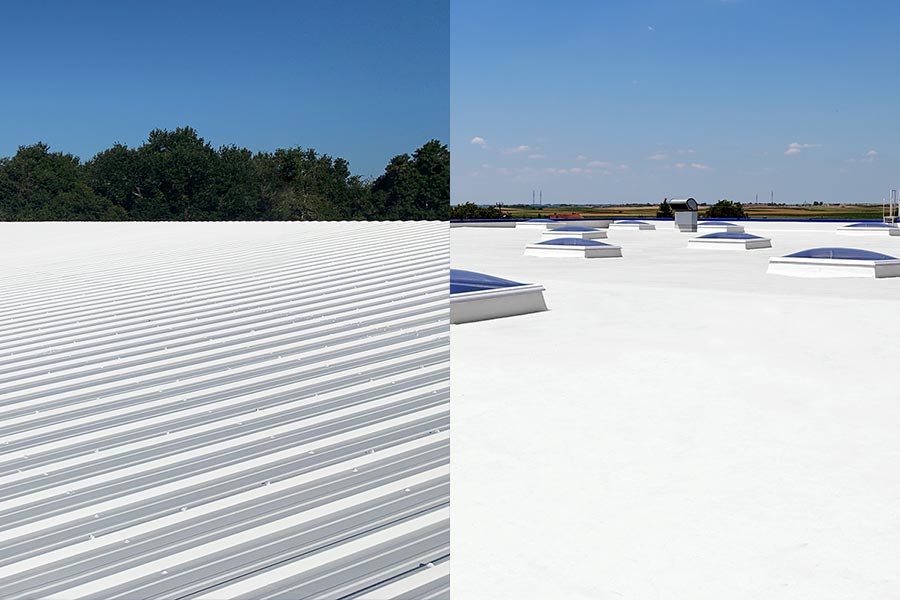Roof coatings are an essential part of keeping your property in great shape and adding an extra layer of protection from the elements. They protect your building against UV rays, rain, and strong winds.
They can also reflect the sun’s rays, helping your air conditioning system to use less energy and lower your energy bills. Besides, roof coatings are renewable, meaning they can be re-coated at intervals to extend their life.

What are roof coatings?
Roof coatings are thick liquid-based formulas that create durable and flexible layers of protection. They are applied to a roof’s membrane and are designed to protect the roofing system against UV degradation, weathering, fire, and water penetration.
Coatings can extend the service life of a roof by several years, depending on the type of coating applied. They also help decrease expansion and contraction (thermal movement) of the roof membrane, thereby reducing the risk of rupture.
The most common types of roof coatings include elastomeric, silicone, and polyurethane. All have their own special characteristics, and you should choose the right one for your particular roof application.
Reflective roof coatings reduce the amount of heat the roof absorbs and reflect solar energy, allowing your building to maintain a lower temperature, even in the summer. This saves you money on energy costs while lowering your carbon footprint.
What are roof coating sprayers?
A roof coating sprayer is a special type of equipment that is designed to apply a specific material to a roof. This material is usually a liquid and is applied as a coating using a high-pressure airless spray gun.
Generally, these sprayers are used to apply acrylic roof coatings or silicone roof coatings. These types of coatings are a popular choice among commercial and residential roofing contractors.
For spraying acrylic roof coatings, you will want to select an airless sprayer that has a high pressure and a good paint flow rate (generally at least 3-4 gallons per minute). A hydraulic airless sprayer will work best for this application.
Elastomeric roof coatings are specialized products that are highly viscous and provide exceptional weatherproofing and thermal insulation qualities. These products require a higher pressure and larger tip sizes to spray properly. They are also hard to pick up and atomize in a standard airless sprayer.
How do roof coating sprayers work?
While there are many different ways to apply roof coatings, the most cost effective (especially for large jobs) is using an airless spray gun. The coating is pumped from the container to a pump where it is pressurized to several thousand pounds per square inch (psi).
It then is sprayed through a gun with a small orifice, usually 0.025-0.040 inches. The high pressure reduces the coating into discrete droplets.
When choosing a roof coating sprayer, look for features like a long hose, high output, and corrosion-resistant internal components. These features will help you maximize your time and avoid downtime while working on the roof.
For example, the Graco 695 roof coating sprayer delivers up to 2.0 horsepower of grunt, which makes it effortless to use with thicker paints. It also comes with a QuikAccess valve for easy fixing of a stuck inlet ball valve, as well as Advantage Drive gears for a quieter spray. These features make the Graco 695 sprayer a great choice for any contractor who needs a powerful and reliable sprayer that won’t break the bank.
What are the benefits of roof coatings?
Roof coatings can help increase the lifespan of your roof and save you money on repair costs. They can also make your roof look more beautiful and add a lot of value to your property.
The type of roof coating you need depends on a number of factors, including the climate you live in and your budget. You can choose from silicone, elastomeric and acrylic coatings.
These types of roof coatings are made from a variety of materials and are available in a range of colors. They can also help protect your roof from moss and algae growth.
Another benefit of roof coatings is that they can reduce energy consumption. They are able to reflect the sun’s heat and UV rays, which decreases the need for air conditioning and heating systems.
Cool roof coatings are becoming more popular, as they can help decrease energy bills and decrease the amount of greenhouse gas emissions from a building. This is especially true for buildings in hotter regions where a lot of sunlight penetrates the roof.
